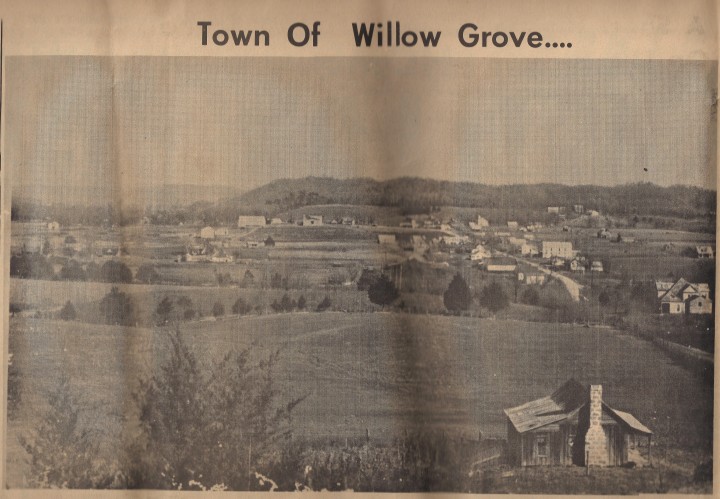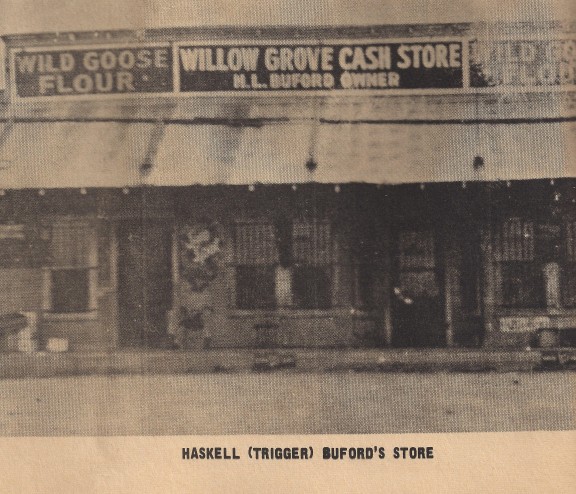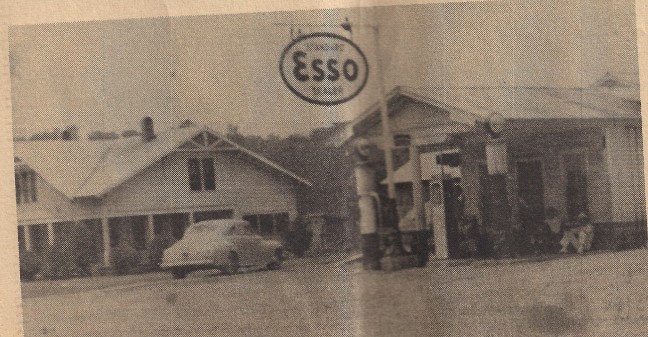
An article printed in the August 8, 1968 edition of the Livingston Enterprise regarding the upcoming homecoming of Willow Grove was written by Clarence M. Holman. Here is a portion of what Mr. Holman had written:
"Willow Grove was small and nestled in the valley of Obed River and on the banks of Iron’s Creek. The Willow Grove community extended over a vast area from hill to hill. There was no approach to the community except by river without going down a hill into the valley which was very beautiful. According to the tradition it derived its name from a grove of Willow trees which at one time surrounded a bold spring that flowed out of the village into Iron’s Creek. As handed down from generation to generation, the creek derived its name from a man by the last name Iron who was one of the early settlers of the area and whose son was killed in a horse race and interned on a knoll in the village over which the school house was erected sometime during the 1800s. When the old building was moved from the knoll for a new school building to be erected in about 1933, Mr. John Brewington who was an aged resident of the community pointed to a spot from which the old building was removed and said, "The Iron boy’s grave should be near here." As the excavation proceeded for the new building, a walnut casket was found that was put together with wooden pegs. The casket was placed under the new building and insofar as we know, it is under the lake today. It is only natural for one whose grandparents were reared in the Willow Grove area before the Civil War to have fond memories of stories told about things that happened more than 100 years ago. One of which we remember vividly is that a hill on the farm last owned by the late Haskell Buford was covered with cedars. At a certain time each year, wild pigeons would come to this cedar grove in such flocks that the elements would be darkened and people would come from miles around to catch the pigeons for food. They were caught by the people using torches with which the pigeons were blinded. The people who inhabited this valley in which Willow Grove was located were justly proud of it. They, for the most part, were of modest means, yet they were self reliant and honorable. And they all had a common interest in the school. It was the nucleus not only of the immediate community, but for several miles around extending into parts of two other Tennessee counties and one Kentucky county. There is, perhaps, no record of the first school in the area, but it was possibly located in the area known as Watson Bend of Obey River. The Honorable Cordell Hull attended school there fore moving further down the river to Celina. Willow Grove Academy began November 13, 1899. This was known as a subscription school. The tuition varied from $1.00 to $3.00. Board could be had for $1.25 per week. We do not known when the public school began but it lasted only a few months each year and was followed by a subscription school for three months each year. The first high school was established in 1919 with Lindsey Hunter as principal. Eddie Watson and Cecil Rowe as students. Both students were graduated from the two year high school. Eddie was later graduated from T.P.I. where he had an outstanding athletic career winning letters in baseball, football and basketball. He later returned as principal of Willow Grove High School, served as head coach at Central High School in Cookeville, and later as Superintendent of Putnam County schools. Cecil Rowe entered the banking business at Livingston where he remained for several years and then became associated with Tennessee Valley Authority at Knoxville. The school continued as a two year high school until about 1927. The principals who served during this period were Lindsey Hunter; a Miss Bilbrey; Raymond Hamilton; John Bell; Elmo Gentry; and Jesse P. Price. It became a 3 year high school in 1927-28 with Ben E. Groce as principal and a 4 year high school in 1928-29 with Frank Spear as principal. Other principals of the 4 year high school were J.B. Lea; JL. Algood; S.D. (Doc) Bilyeu; W.T. Cherry; F.L. Sidwell; Eddie Watson; Earl Watkins; Winfred Kirby; Maurice Anderson; and Kermit Smith. The school was disbanded in 1942. We are not in a position to know the number who were graduated from Willow Grove High School, but we do know of more than 450 who attended school there and who now live in at least 19 different states. It would be utterly impossible to determine the occupations and professions of all the people who were graduated from this school, but we do know that some became bankers; farmers; engineers; medical doctors; veterinarians; pharmacists; ministers; teachers; salesmen; and business men in different types of industry. The principal recreation of the community, aside from fishing and hunting, was athletics. Most all former residents will cherish the memories of the baseball and basketball teams. This is especially true of those who recall the days when the teams traveled by horseback to surrounding towns. There was also an annual fair that was an exciting three day event beginning on Thursday and lasting through Saturday. The fair grounds adjoined the school campus. School was always suspended on Friday for the fair. Thursday, at school, was almost more than a group of kids could take with the excitement coming from hearing the blare of the imported band and the loud cries from the ring master as he announced each competitive event. As we conclude our reminiscing about Willow Grove, we would like to suggest that the joint annual reunion of Celina and Willow Grove High Schools is a wonderful occasion for old friends to get together. Thank you for indulging."

